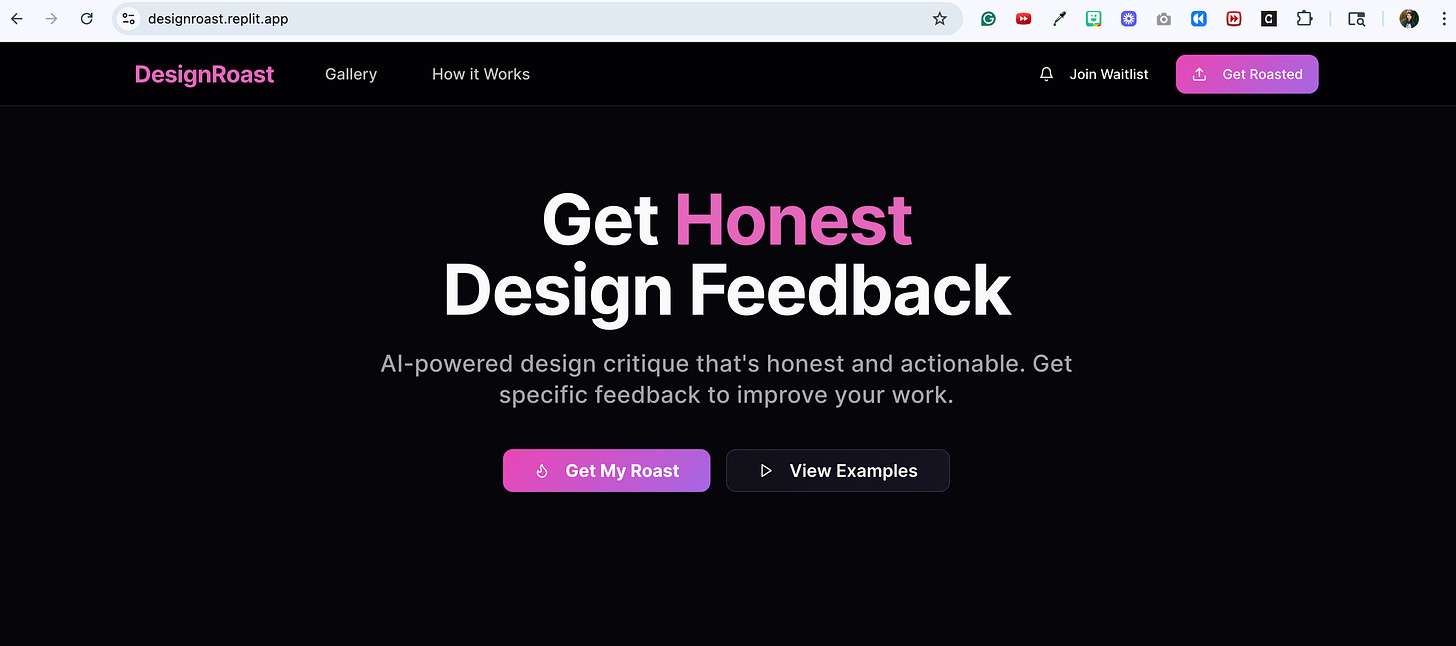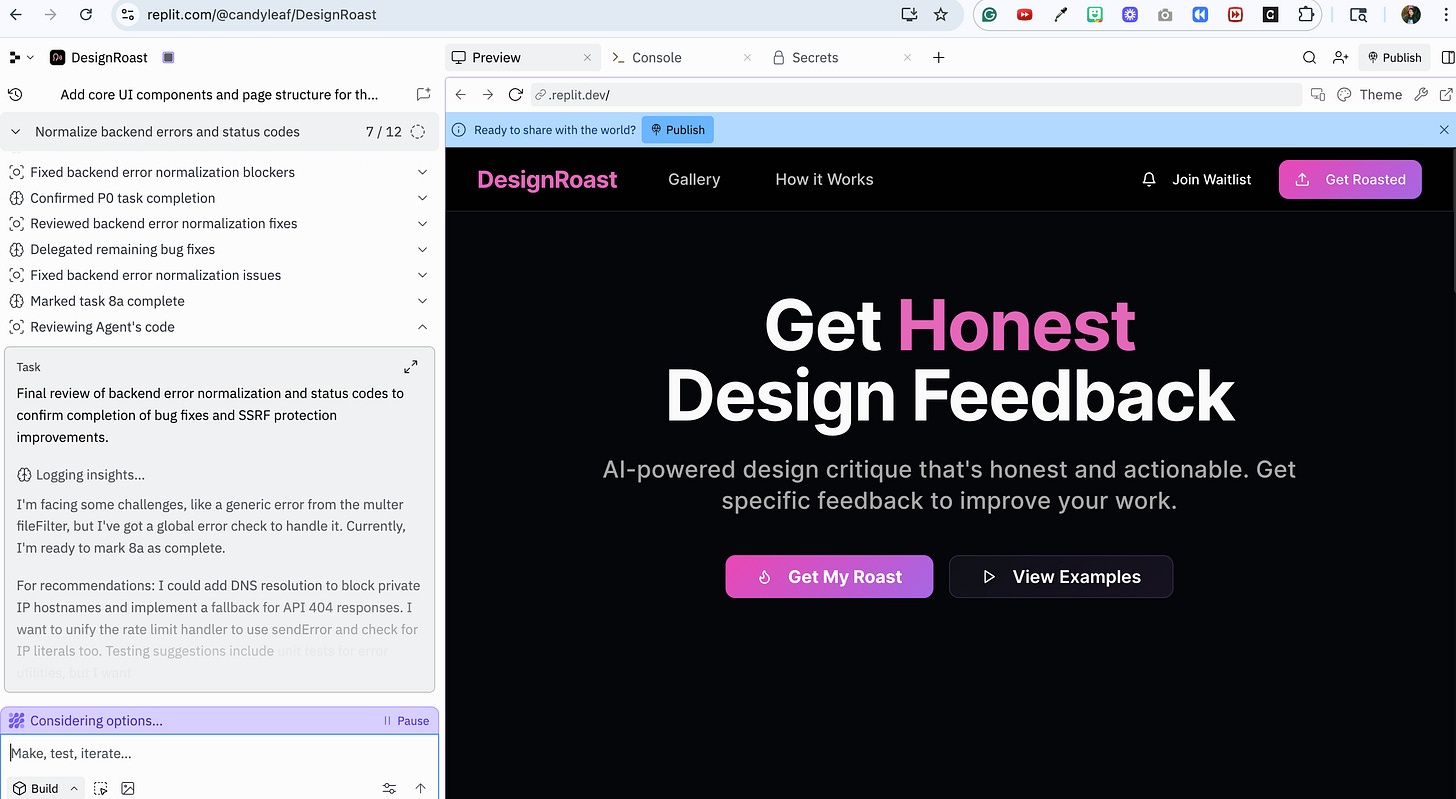Designing for AI Agents & UX Patterns
AI agents represent the next evolution of artificial intelligence as autonomous systems that can perceive their environment, make decisions, and take actions to achieve specific goals. Unlike traditional AI tools that respond to direct prompts, agents operate with greater independence, managing multi-step workflows and adapting their behavior based on context and feedback.
Think of them as digital assistants with agency. While a chatbot might answer your questions, an AI agent can book your flight, reschedule conflicting meetings, and update your calendar all from a single request. They bridge the gap between user intent and execution, handling the complexity behind the scenes.
This newsletter is brought to you by Replit, who is launching Agent 3 today to help you vibe code better apps. Inspired by our design feedback/roasting sessions, we’ve vibe coded DesignRoast with Replit’s new Agent 3. Check it out here (it’s an MVP, may be buggy but we’re working on it):
Agent 3 tests and fixes the code automatically and enables you to build more complex apps: https://replit.com/agent3
It’s also like your intern! You tell it what to do, it will take some time to build AND design, you tell it what changes to make, and keep iterating. You can even ask it questions and build a full product without needing to touch code.
Stay tuned for some more special Discord bots for Design Buddies, too!! 👀
Get free Replit credits and let us know what you build with Agent 3:
The UX Challenge: Designing for Autonomy
Creating user experiences for AI agents presents unique challenges that traditional interface design hasn't had to address:
Trust and Transparency: When an agent acts independently, users need to understand what it's doing and why. The "black box" problem becomes critical when agents make decisions that affect real-world outcomes.
Control vs. Convenience: Users want the efficiency of automation but need to maintain agency over important decisions. Finding the right balance between autonomous action and user oversight is crucial.
Contextual Awareness: Agents must understand not just what users say, but what they mean within their specific context, environment, and current situation.
Error Handling and Recovery: When agents make mistakes (and they will), the recovery process must be seamless and educational, helping both user and agent learn from the experience.
Agent UX Patterns
1. The Progress Reveal Pattern
What it is: Gradually showing users the agent's reasoning and actions as they unfold.
Example: Replit’s Agent 3 does this, you prompt it to make something and tells you what the agent is doing in the background:
Each step reveals the agent's thought process, building trust through transparency.
Why it works: Users can intervene at any step if the agent is heading in the wrong direction, and they learn how the agent approaches problems.
2. The Context Window Pattern
What it is: Showing users what information the agent is considering when making decisions. (prevents AI hallucinations)
Example: Perplexity AI displays this elegantly by showing:
Sources being consulted in real-time
Which parts of previous conversation it's referencing
External context it's pulling in (current date, location, etc.)
Why it works: Users can spot when the agent is missing key context and provide corrections before errors compound.
3. The Teach-Back Pattern
What it is: Having the agent explain what it learned from user corrections.
Example: When users correct Claude's code suggestions, it might respond: "I understand now—you prefer using functional components over class components for this project. I'll apply this pattern to future suggestions."
Why it works: It demonstrates learning and helps users understand how to give more effective feedback.
4. The Collaborative Workspace Pattern
What it is: Creating shared spaces where users and agents can work together iteratively.
Example: Replit editor implements this through:
Side-by-side code generation where users can edit agent output in real-time
Inline comments where users can give feedback on generated code
Version history that shows the evolution of human-AI collaboration
Why it works: It feels like true collaboration rather than a handoff between human and machine.
Designing the Agent Relationship
The most successful agent experiences don't just solve functional problems—they cultivate a relationship between user and agent. This means designing for:
Personality Consistency: Your agent should have a recognizable voice and approach that users can predict and rely on.
Learning Loops: Clear feedback mechanisms that help both user and agent improve over time.
Boundary Setting: Making it easy for users to define what the agent should and shouldn't do autonomously.
Recovery Rituals: When things go wrong, the process of getting back on track should strengthen rather than damage the relationship.
Want Help Getting Ready? That’s What Cohort 21 Is For.
Cohort 21 is built specifically to help designers like you break into the world of high-impact product design with real VC-backed startups.
In 10 weeks:
- You’ll be the designer who ships real products with engineers, PMs, and founders
- You’ll design side by side with a big tech team and big tech coach
- You’ll be the designer who presents to SF’s top founders, hiring managers, and design leads. Gain work experience, and a killer portfolio/resume piece
- Get hired through the cohort, and grow with guidance from alumni who’ve done it before. You'll work on a really good project/team and have a killer portfolio piece
Cohort starts late September 2025, apply ASAP because we sold out last summer: https://www.cocreate.careers/post/apply-to-cohort-20---land-your-dream-job
Upcoming events
[Online] Navigating feedbacks and pivots as product design team at VC-backed startups (Thu Sep 11, 6 pm pacific ) https://luma.com/ch20-insight4
[Online] Design feedback Friday (Fri Sep 12, 11 am pacific): https://luma.com/zzs9hk7u
[IRL, San Francisco] Big Design Energy (design demo day, Mon Oct 6, 5:30 pm during SF tech week IRL): https://luma.com/design-demo
Resources
20% off for Mobbin, the world’s largest library of real-world design inspiration! https://mobbin.com/designbuddies
Some recent job openings, email Grace Ling grace@designbuddies.community with your portfolio and resume for a chance to get referred
Founding designer https://superflexteam.notion.site/Founding-Designer-Wonder-23464cd88e458076a81ac6636f0f24be
Graphic designer https://jobs.sociallyinept.io/designer
Apply for CoCreate Cohort 21 ASAP, we sold out last summer → https://www.cocreate.careers/post/apply-to-cohort-20---land-your-dream-job
🐰 About CoCreate (Design Buddies/UXGO - we’re the same team)
CoCreate (Design Buddies/UXGO) is a community where you level up your design career. Land jobs, improve your design skills, and make friends. We have resources, events, design challenges, job boards, fun perks, and more.
👋 Visit our website and hop into our Discord community.
💖 Partner with us, or share your resources in our newsletter (email grace@designbuddies.community)
🌟 Watch our past events and connect with us on Instagram, Twitter, and LinkedIn for more fun!
👩🏻💻 Subscribe to Grace Ling’s newsletter, Grace Pace!
Got anything else you’d like to see in our newsletter and community? Please email grace@designbuddies.community





